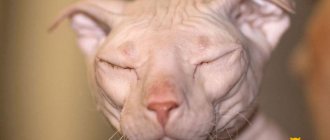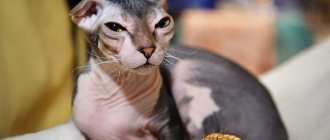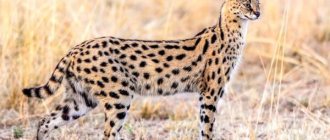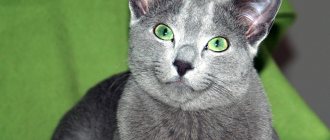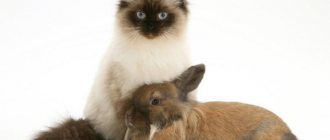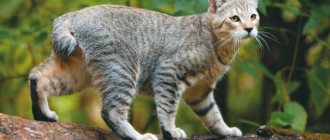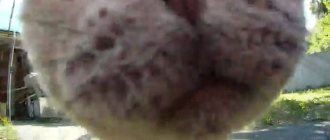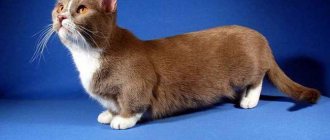The serval cat is a small mammal from the cat family. These are real hunters by way of life and vocation, and at the same time they are the rarest breed of furry pets. This cat, more like a cheetah, is a standard example of grace and beauty. No person will remain indifferent to this miracle of the animal world.
The popularity of the Serval as a domestic cat is growing day by day. The playful disposition, sociability and intelligence of charming creatures have made the breed one of the most desirable for humans.
Origin, description and appearance
The Serval cat breed is one of the rarest, and therefore enjoys well-deserved respect among connoisseurs.
The Serval is a cat that has been tamed and made the main decoration of any home.
The distinctive factor is its special color, visually reminiscent of a cheetah, and grace.
Servals are wild cats that live throughout Africa, except the Sahara Desert. People managed to domesticate them.
Appearance:
- short hair;
- color features - numerous dark spots;
- the height of an adult animal reaches 0.6 m at the withers;
- body length - about 1.1 m;
- tail length approximately 30 cm;
- paws are long, thin;
- medium sized head;
- the ears are large and wide, rounded at the top (at the base at the top, each ear is covered with thick light fur);
- the eyes are almond-shaped, curved in the upper part;
- the nose is large and pronounced.
Standard colors for the breed:
- light beige (dark spots);
- beige-red with dark spots or stripes.
The chest and belly are light (milky or white, without spots). Average weight – 10-18 kg.
Color options
Leopard cats have inherited a patterned coat called tabby, a spotted cat like a leopard. This is a unique feature that makes Bengalis so loved.
Depending on the background of the coat, tabby color is divided into the following types:
- Brown tabby. With this color, the cat looks like a leopard. The sand-colored coat has black spots.
- Silver tabby. With this color, your pet looks like a snow leopard. The background of the fur is silver.
These two types are further divided into 3 categories, taking into account the figure:
- Spotted. The animal is covered with spots that have a uniform dark color.
- Rosette. This name came about because of the unusual spots that have a clear dark edge and a lighter one). This color of leopard cats is considered classic, therefore the most famous and popular.
- Marble. With this type of color, there are no obvious spots on the body of the animal, but there are beautiful dark patterns. Their shape and size may vary.
Among the classic options, it is worth noting the so-called “Leopardette” color. It is closest to wild natural options. Color - dark chocolate or reddish brown. The Sorrel marbled leopard cat is characterized by coffee-colored spots on a golden background. The tail is decorated with a dark tip. In addition to animals with classic colors, black and blue Bengals were also bred.
The charcoal color is sometimes classified as a brown tabby, but they still have certain differences. The background of the coat with this color has a cold tint. The nose and eyebrows are jet black, and the “spectacles” around the eyes are light in color.
The blue color of this breed is considered rare
. The background of the coat is gray-blue, with a metallic tint. The color of the spots is very unusual - gray, shimmering with a blue tint. Another rare option is very light coat with a barely noticeable pattern, which is why such cats are called snow bengals.
Before purchasing a Bengal cat, it is recommended to read the pedigree description to be sure that it is separated by at least five generations from its direct ancestor, the Asian leopard breed. Otherwise, the pet may have a hot-tempered and quarrelsome character.
It should be noted that, like humans, each animal has individual characteristics. Any individual pet will have its own habits, character and illnesses
But what is important for all of them is the love and attention of the owner
When choosing a kitten, everyone is guided by certain requirements or wishes for their future pet, for example, breed, coat color, eye color, shape or size of ears, or even the size of an adult animal. Today we will talk about those cat breeds that resemble tigers in their coat color, that is, about tiger-colored cat breeds
, as well as about
breeds of leopard-colored cats
. Let us note in advance that only one breed of cat has a true “tiger pattern” of coat, but several have the leopard pattern.
Breed character and habits
The Serval breed is a born predator. Home is his territory, which he constantly explores.
The Serval breed is a born predator.
Distinctive character traits:
- curiosity;
- speed of reaction;
- mobility;
- ability to run fast;
- agility (the pet is able to jump to a height of up to 3.5 meters).
The kitten must learn to be affectionate. This should be done from 2-3 months.
Behavioral characteristics comparable to a dog:
- the cat can walk on a leash;
- bring small items to the owner.
The cat shows devotion and affection only to one person ; the rest of the family will be content with a neutral or friendly attitude.
Due to its wild nature, the animal's character is independent but gentle. The manifestation of affection for the owner is expressed by purring. Cats also love to rub against your legs and jump on your hands.
Important rule! It is advisable that there are no other animals in the house (servals can hunt birds or small rodents) or children (cats cannot tolerate loud or sharp sounds, squeezing and snuggling).
A cat shows devotion and affection only to one person.
It is prohibited:
- beat animals;
- kept in captivity (in cages or small pens);
- hold in your arms for a long time against your will.
Important! In order for the serval to understand that the boss is the owner, he should not be allowed to bite his arms or legs, even during play.
Rare spotted cats
Since the leopard pattern is popular among cat lovers, breeders are constantly experimenting with creating new varieties of tabbi-spotted pets.
Australian smoke
Australian smoke
Fluffy pets from the Australian continent count among their ancestors a whole “bouquet” of representatives of various breeds, including Abyssinians, Burmese and Siamese, as well as ordinary yard cats. From their aristocratic ancestors, Australians inherited elegance and grace, and from mongrel purrs - good health. The tabbie color is quite common in these cats. The character of Australians is flexible, their temperament is energetic and restless. Outside Australia, representatives of the breed are not often found.
California radiant
The goal of California Shining's creators was to create a domestic cat that resembled a leopard to remind people of the importance of preserving wildlife. The starting material was a variety of breeds: Siamese, Angora, Abyssinian, Manx, British Shorthair.
California radiant
Californians have a lean body structure, developed muscles, and a high level of intelligence. Animals are open to communication, inquisitive, love to frolic and jump. They take part in group games with pleasure. The spotted skin can have one of the following shades: black, blue, silver, gold, bronze, brown, red, smoky charcoal.
Ussuri
The young breed, descended from Amur forest cats and Siberians, is not yet very widespread. The surface of the spotted coat is colored in golden-fawn tones, the belly is slightly lighter. Its character resembles that of a predatory animal, cautious and distrustful. Extraordinary hunting abilities.
Kenyan (soukok)
Kenyan forest cat (soukok, sokoke)
Cats from the very heart of Africa differ in gene composition from ordinary domestic purrs. The ancestors of these flexible, muscular, marbled beauties are considered to be feral pets that formed pairs with four-legged small predators from the African forests. Despite their wild origins, Kenyans are distinguished by their flexible and calm disposition. Curious, active, friendly.
Care and maintenance
Attention must be paid to care and maintenance. Since the pet’s body and overall dimensions are large, it is recommended that cats be purchased by those who can provide them with a spacious room.
Be sure to read:
Is it possible to tame a Pallas's cat: how to keep and care for it, possible problems, what not to do
Small rooms or standard apartments can cause aggression - nature will take over, and the cat will begin to damage the furniture and scratch corners.
Tray training occurs in 1-2 days. A regular toilet won't do. You need a large tray with sides. Filler – pebbles, silica gel.
Hygiene
Hygiene procedures are an integral element of caring for any cat. Bathing is one of the Serval's favorite activities, which distinguishes it from 99% of other cat breeds.
Tray training occurs in 1-2 days
It is recommended to bathe your pet once a week. A person should also remember that short but warm hair will need to be combed regularly (once a week). Hygiene involves cleaning the ears with cotton swabs.
Diet and feeding
Since the serval is a predator, its main food is meat in various forms. The diet should include poultry (chicken, turkey) and offal.
The animal should receive calcium from special complexes containing vitamins and minerals (it is not advisable to include milk in the diet).
If dry food is used, then regular drinking water should always be freely available. Feeding is done 2 times a day. To control weight, it is recommended to arrange fasting days once a month (exclude feeding for a day).
Education and training
A high IQ allows for training. Servals are capable of learning and can perform tricks of varying complexity: high and long jumps, carrying objects in their teeth, etc.
It is recommended to start education from the very first days. If cats start scratching furniture or wallpaper, you will need to buy a scratching post and treat the damaged areas with a special compound to stop them from spoiling things.
Life expectancy and typical diseases
The life expectancy of representatives of this breed at home reaches 20 years.
Servals do not have any typical diseases.
Servals do not have any typical diseases. Regular vaccination is recommended.
Be sure to read:
The most ancient predator is the wild cat Manul, the second name of Pallas's cat: character, behavior
The most common health problems:
- hypothermia;
- diarrhea and dehydration;
- injury.
Since cats are very active and love to jump, in most cases paw injuries occur (usually in kittens, since their skeletal system is not yet fully formed).
Castration and sterilization
When choosing this breed, you need to remember that both the male and the female are capable of marking their territory. The liquid has a strong unpleasant odor, which is very difficult to get rid of.
That is why for representatives of this breed castration and sterilization are mandatory procedures if the animals are not used for breeding. Age when surgery can be performed: 12-14 months for females and 7-8 months for males.
Security status
Increasing human populations and agricultural developments have impacted the decline of African servals' habitat and their prey. This leads to hunting by domestic animals as it is an easy and highly nutritious food. Although the threat from these cats is minimal, farmers regularly shoot them. Although the cat population is listed as Least Concern by the IUCN, the subspecies Leptailurus serval constantina is listed as endangered by the US Fish and Wildlife Service.
Breeding
When choosing this breed, you need to remember that both males and females are capable of marking their territory.
Sexual maturity in representatives of the cat family begins at 1.5 years. During this period, they become more active and may exhibit aggressive behavior, so it is necessary to closely monitor the animal.
Mating and partner selection
Keeping a cat assumes that if castration (sterilization for cats) is not carried out, then you will need to think about mating. Servals are able to mate with ordinary cats, as well as caracals.
The choice of a partner depends on the goals - to preserve the breed and for breeding purposes, it is recommended to choose only a serval for mating.
Pregnancy and childbirth
The age at which pregnancy can begin is about one and a half years. The gestation period is 65-75 days. There can be 1-3 kittens in a litter.
The birth process in 95% of cases goes smoothly and without complications, but contacting a veterinarian is mandatory to exclude any complications for the mother and babies.
Savannah price
It is also immediately worth noting why the price of these animals is so high. This is due to the fact that breeding savannas is a very troublesome and time-consuming business. After all, you need to cross two different breeds with different gestation periods (domestic cats have less), and this implies premature kittens and a high mortality rate. They require especially careful care. You should also understand that the babies will be quite large due to the nature of the breed, so natural childbirth is not always possible. A caesarean section is often necessary, which is an expensive operation.
Characteristics of this breed
The serval is a noisy and active animal . It requires increased attention and loves to spend time playing games. You can go for a walk with him using a leash.
Size and weight gain
The size of the animal is large - length 1.1 m, height more than 1.5 m. Weight gain occurs quickly, so it is important to monitor nutrition.
Shedding
Short hair does not leave marks if combed out in a timely manner. Shedding occurs in the autumn, then it is recommended to use a special brush 2-3 times a week.
Allergy
Servals are hypoallergenic breeds. In 95% of cases there is no negative reaction from the body.
Be sure to read:
A cat that looks like a lynx: the best domestic and exotic breeds, features of their maintenance
Interesting Facts
Official recognition of servals as a domesticated cat breed took place in the middle of the 19th century, so a lot of interesting things are already known about them:
- Due to the fact that these animals often chose dense, tall bushes to make their “home”, they are also called bush cats.
- Servals can communicate using a variety of sounds. They express emotions and attract attention by purring, growling, squawking and even chirping.
- In the wild, bush cats lead a solitary lifestyle. The average area occupied by 1 serval is 4-20 km2.
Where to buy and how much does a kitten cost?
Serval kitten
It is recommended to purchase a kitten from trusted breeders or a nursery. The breed is rare and expensive, so there is a risk of encountering scammers.
You can avoid problems by contacting professional breeders who will issue all supporting documents.
What to pay attention to
When purchasing, you should pay attention to the characteristic features of the breed - dimensions, appearance, color.
You also need to look at the behavior of the animal - if it is healthy, it will be playful and quick, the eyes should be light and clear without clouding or discharge.
Approximate cost of a kitten
The price of the animal varies. It depends on the purity of the breed (a spot on the chest reduces the cost), and age. The cost starts from 150,000 rubles and reaches 500,000 rubles and above.
Area
Servals are wild cats of Africa, originally found throughout its territory, now found in the southern part of the continent, especially in Zimbabwe and South Africa. Small populations are found in the Atlas Mountains. They have also been found in Algeria, Morocco, Ethiopia, and sub-Saharan Africa. Thanks to translocation efforts, individuals of this species can now be found in northern Tanzania.
Table: pros and cons of the breed
The advantages and disadvantages of the Serval breed are presented in the table:
| pros | Minuses |
| Exotic wild color | Large size (needs spacious housing) |
| High IQ (ability to learn) | Rancor and resentment |
| High life expectancy – up to 20 years | Strong odor of genital secretions (requires castration or sterilization unless diluted) |
| Love for water procedures | Do not keep small breeds of dogs or rodents together (they can become prey for a predator) |
| Devotion and activity | 30% of vaccines are not used |
| Absence of characteristic diseases | The basis of the diet is meat (it is necessary to feed up to 1 kg daily) |
| Possibility of walking on a leash | High price |
Toyger - domestic tiger
www.pawprovince.com
There are several breeds similar in color to the leopard, and only one whose pattern follows the stripes of a wild tiger. Toygers were officially recognized less than 10 years ago, and now there are only about fifty nurseries in the world that breed them.
Unlike Savannahs and Bengals, which need a lot of space, Toygers feel great even in a small apartment. They love children, get along well with other animals and are generally more reminiscent of a plush toy than a wild animal.
History of origin
The first savannas were born in the 80s. last century from the unusual union of a domestic cat and a serval - a strong and freedom-loving animal. Breeders sought to breed a cat that looked as close as possible to a wild one.
The first results of numerous crossings were obtained in 1986. Two kittens were born. They were distinguished from domestic cats by their spotted color, characteristic wild look and very large size.
In order to obtain such an unusual breed, breeders had to make a lot of effort. Not only domestic cats and servals took part in the crossing, but also other representatives of the animal world - Bengal and Siamese cats, Egyptian Mau.
The kittens were immediately accepted into TICA - the International Cat Association. But the breed was officially registered only at the beginning of the two thousandth. Hundreds of people around the world instantly became her fans. But buying an exotic pet is not so easy. This breed is still very rare due to some difficulties in obtaining offspring.
Egyptian Mau
Size: 7-9 lbs.
Lifespan: 13-16 years
Personality: I love heights, active, strong-willed
The Egyptian Mau has long, slender legs and the personality of an Egyptian god/goddess. They love to climb and hang out at high altitudes to observe their kingdom and items. They are also fast runners and require a lot of space to run and play.
Click on the image to view full size
Bengal
Size: 6-15 lbs.
Lifespan: 14-16 years
Personality: Curious, playful, intelligent, active
In 1963, Jean S. Mill (who is the mother of Judy Sugden, who raised Toyger) developed the Bengal by crossing small wild Asian leopard cats with common domestic shorthair cats. The result is a cat that appears wild but gets along with people and other animals, including dogs.
The Bengal cat is a very intelligent, active and curious cat that loves to climb trees and be outside and can be leash trained. It requires stimulation, entertainment and attention. Do not plan to get this cat if you are going to be away from home for most of the day.
Click on the image to view full size
American Bobtail
Size: 7-16 lbs.
Lifespan: 13-15 years
Personality: Friendly, intelligent, loyal, calm
This wild-looking cat is a softie at heart. He will appeal to anyone who gives him attention and enjoys company, be it people, other cats or even dogs. He is calm, friendly and adaptable. They are wonderful travelers and therapy cats because they get along so well with everyone and have a calm and friendly personality. If you've ever dreamed of having a cat with the personality of a dog, the American Bobtail is the cat for you.
Serengeti
Size: 8-15 lbs.
Lifespan: 13-15 years
Personality: Active, loves heights, friendly
This designer breed was created in 1994 by Karen Sausman, a conservation biologist who selectively bred Shorthairs and Bengals together to create the wild marks you see today. The Serengeti is a friendly cat that loves to jump and climb. If this cat doesn't get stimulation in the form of human interaction or interactive play, she will find her own entertainment (like destroying your house).
Click on the image to view full size
Bombay
Size: 8-12 lbs.
Lifespan: 15-20 years
Personality: Tolerant, calm, playful
Bombay looks like a miniature black panther, but he is not at all ferocious. He prefers to play and relax around the house in the company of his people. Bombay is calm, affectionate and tolerant of dogs and other people. However, since he enjoys being the center of attention, he may become jealous of other cats.
Click on the image to view full size
Pixie Bob
Size: 8-11 lbs.
Lifespan: 15 years
Personality: Loyal, sociable, playful
Pixie Bob was the result of an unplanned breeding between a bobcat and a barn. While he looks like he belongs in the wild, the pixie bob is gentle and affectionate. He is extremely loyal to his family and gets along with everyone he meets, including dogs.
Click on the image to view full size
Abyssinian
Size: 8-12 lbs.
Lifespan: 9-15
Personality: Active, affectionate, playful, curious, alert, intelligent
The Abyssinian is constantly moving - whether jumping, running or exploring every corner of the house and yard. He needs a lot of interaction with people and toys, especially puzzles, to keep his brain active. If you think this cat will be happy to sunbathe and snooze when left alone, you wouldn't be wrong. He needs company and someone to play with, and will act out if he's bored.
